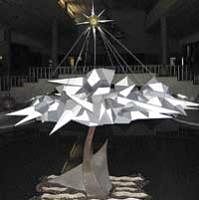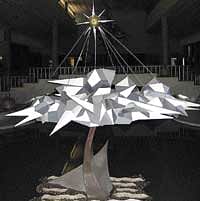

In a region known for its historic havelis and spectacular fresco paintings, this is a somewhat unusual attraction in the kaleidoscopic geography of Shekhawati. On a visit to the desert with a keen desire to take a peep into the fascinating past, it is almost like an odyssey of discovery. A new age museum!
Situated in Pilani's famous BITS (Birla Institute of Technology and Science) campus, Birla Museum has the proud distinction of being country's first science museum. Conceptualised by noted industrialist Ghanshyam Das Birla, who hailed from this non-descript town of Shekhawati in Rajasthan, it showcases modern science and technology through animated exhibits and audio-visuals. Like BITS which is among 10 top most IIT institutes in the country, Birla Museum enjoys a special place in the new generation museums in India. It has the whole spectrum of accomplishments in the country in science, technology, space and aviation. It is designed to attract visitors of all ages and backgrounds, allowing them freedom to have hands-on interaction with complex scientific principles in a simple way.
Birla Museum Director V N Dhaulkhandi told Deccan Herald that Birlaji got the idea of establishing this museum during his visit to the UK Imperial Institute. He was so impressed by the dioramas exhibiting Indian men at work in fields or industries that he even purchased ten exhibits. The exhibits unfortunately got damaged while being transhipped to India, but Birlaji still decided to go ahead with the museum which came up in 1954. The exhibits were repaired by local artistans under the supervision of V P Beri, who also remained director of the museum till 1996. The museum now has nearly 400 exhibits covering a vast range of scientific subjects like energy, metallurgy, space and chemical science.
The elegant museum building unfolds an exciting world of science to the visitors-a big SLV-3 rocket ready to take flight, lissajous pendulum creating lovely design with its harmonic motion and Yam, the robot eager to shake hands-and much more. The visit cannot be a passive activity since the museum is designed on "Do it yourself" principle.
The science section called the Gallery Eureka is the most popular one, says engineer Vikram Arora. Here science is fun, made easy to interest everyone and particularly beneficial for those with a bent of scientific mind. The participatory nature of the museum allows anyone to push the buttons, fiddle with the exhibits and even break them to have hands on experience of scientific facts. Most exhibits swing into action as soon as one presses a button. Dramatic display and wonderful use of light and colour make it an unforgettable experience.
The museum building has an impressive sculpture at the entrance, symbolic of the past achievements, projects that are on hand and the future goals. The 14-seater Dakota aircraft used by G D Birla also attracts a large number of visitors. It is beyond one's imagination to think such a rich treasure trove of scientific marvels can exist in this non-descript town of the desert.
It is a systematic, step by step, display of scientific principles through visual art forms. The energy segment offers an insight into the solar, thermal, hydro, atomic energy plants. The space world brings you closer to the Hubble telescope, Chandrayaan, space shuttle and an exhibit of astronaut Rakesh Sharma reminds us of India's great strides. Then there are innovations in marine engineering, aviation, agriculture, industries-coal mines, copper mines, jute mills, transport, electronics and a glimpse of all planets, beautifully exhibited through dioramas.
The three-dimensional dioramas enclosed in glass showcase, have a special effect due to the painted background. This gives a sense of larger space and the viewer is not distracted by corners, seams or edges, explained Vikram Arora. "All exhibits are handmade, made by museum's own staff artisans."
Some of the seasoned artisans like Kishori Lal and Ramji Lal have had no formal education in science but they are superb in "mechanical animation techniques", he said. The engineers give them the design and concepts and they produce excellent exhibits with their ingenuity, he added.
Majority of the exhibits are beautifully miniaturised but a near life-size coal mine is the special attraction at Birla Museum. Perhaps the only one of its kind in Asia, visitors get a chance to go deep down to witness the entire process of coal mining amidst realistic setting and life-size figures.
Though the idea was conceptualised by late G D Birla, his eldest son Laxmi Narain Birla, a gifted artist and writer, contributed in a big way in developing it as one of the most modern and educational museums of India. Birla museum also has a rich collection of rare paintings, by western and Indian painters, the original works of Daniel, Hodges and Hussain, Nandlal Bose, Jamini Roy and Rabindranath Tagore, all acquired by LN Birla from home and abroad. The art gallery, the armoury section, century's progress gallery and G D Memorial Hall add to the aesthetic flavour of the museum. The Gandhi gallery is reminiscent of Birla family's close association with Mahatma Gandhi.
The director says nearly 80,000 students from Rajasthan and outside visit the museum every year besides 1.25 lakh other visitors from India and abroad. The exhibits are updated and renovated to keep pace with latest innovations, he said.